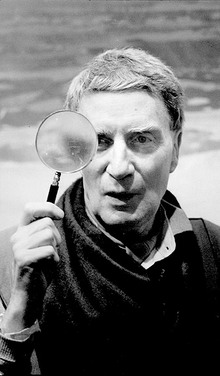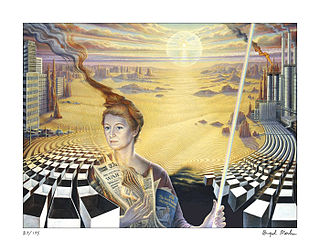
Brion Gysin was a British-Canadian painter, writer, sound poet, performance artist and inventor of experimental devices.

Hildegard of Bingen, also known as Saint Hildegard and the Sibyl of the Rhine, was a German Benedictine abbess and polymath active as a writer, composer, philosopher, mystic, visionary, and as a medical writer and practitioner during the High Middle Ages. She is one of the best-known composers of sacred monophony, as well as the most recorded in modern history. She has been considered by scholars to be the founder of scientific natural history in Germany.

William Seward Burroughs II was an American writer and visual artist. He is widely considered a primary figure of the Beat Generation and a major postmodern author who influenced popular culture and literature. Burroughs wrote eighteen novels and novellas, six collections of short stories and four collections of essays, and five books have been published of his interviews and correspondences; he was initially briefly known by the pen name William Lee. He also collaborated on projects and recordings with numerous performers and musicians, made many appearances in films, and created and exhibited thousands of visual artworks, including his celebrated "Shotgun Art".

Outsider art is art made by self-taught or supposedly naïve artists with typically little or no contact with the conventions of the art worlds. In many cases, their work is discovered only after their deaths. Often, outsider art illustrates extreme mental states, unconventional ideas, or elaborate fantasy worlds.

Visionary art is art that purports to transcend the physical world and portray a wider vision of awareness including spiritual or mystical themes, or is based in such experiences.

Adolf Wölfli was a Swiss artist who was one of the first artists to be associated with the Art Brut or outsider art label.
The Vienna School of Fantastic Realism is a group of artists founded in Vienna in 1946. The group's name was coined in the 1950s by Johann Muskik, and the first exhibition was in 1959 at the Vienna Belvedere. This Austrian movement has similiarities to Surrealism in its use of religious and esoteric symbolism and also the choice of a naturalistic style, countering the prevalence of abstract art movements at the time.

Ernst Fuchs was an Austrian painter, draftsman, printmaker, sculptor, architect, stage designer, composer, poet, and one of the founders of the Vienna School of Fantastic Realism. In 1972, he acquired the derelict Otto Wagner Villa in Hütteldorf, which he restored and transformed. The villa was inaugurated as the Ernst Fuchs Museum in 1988.
Timothy James "Matthew " Fox is an American priest and theologian. Formerly a member of the Dominican Order within the Catholic Church, he became a member of the Episcopal Church following his expulsion from the order in 1993.
Viriditas is a word meaning vitality, fecundity, lushness, verdure, or growth. It is particularly associated with abbess Hildegard von Bingen, who used it to refer to or symbolize spiritual and physical health, often as a reflection of the Divine Word or as an aspect of the divine nature.

Fantastic art is a broad and loosely defined art genre. It is not restricted to a specific school of artists, geographical location or historical period. It can be characterised by subject matter – which portrays non-realistic, mystical, mythical or folkloric subjects or events – and style, which is representational and naturalistic, rather than abstract – or in the case of magazine illustrations and similar, in the style of graphic novel art such as manga.
Ordo Virtutum is an allegorical morality play, or sacred music drama, by Hildegard of Bingen, composed c. 1151, during the construction and relocation of her Abbey at Rupertsberg. It is the earliest morality play by more than a century, and the only medieval musical drama to survive with an attribution for both text and music.

Brigid Marlin is an American artist based in Hertfordshire, UK. She studied in Dublin, Montreal, New York, Paris and Vienna where, under the guidance of the Austrian artist Ernst Fuchs, she learned the oil and egg tempera technique (Mischtechnik) of the Flemish and Italian Renaissance painters Jan van Eyck and Giovanni Bellini. In 1961 she founded the ins-cape group, which subsequently became the Society for Art of Imagination.

Saint Bertha of Bingen was the mother of Rupert of Bingen. Her biography was written, and subsequently her cult popularized, by Hildegard of Bingen, who lived in the same region, about four hundred years later. Bertha and Rupert share a feast day on 15 May.

Amanda Sage is an American painter who has studied and worked in Vienna, Austria and Los Angeles, California. She trained and worked with Ernst and Michael Fuchs, a classical artist who taught her Mischtechnik. Through Fuchs she came to know other Visionary artists with whom she has worked, exhibited and co-founded the Academy of Visionary Art in Vienna and the Colorado Alliance for Visionary Art. Sage is a lecturer, teacher, and live artist with works in international galleries and museums.

Peter Gric, or Petr Gric, is an Austrian painter, drawer, and illustrator originally from the Czech Republic. Motives of futuristic landscapes and architecture, biomechanical surrealism, and fantastic realism can be found in his work. Gric is a member of the art groups Libellule and Labyrinthe.
Lukáš Kándl is a Czech magic realist artist. He began specialising in oil painting at the Prague College of Art from 1959 to 1963. He continued his graduate study at the Prague Academy of Applied Art. In 1969, Kándl received his master's degree from the Academy of Fine Arts. Kándl held his first solo exhibition in Köln, Germany, in 1973, and this was followed by a string of exhibitions in Europe, Asia, Australia and America. He currently lives with his family and maintains a studio in Saint-Germain-en-Laye, France. Kándl is an honorary Member of the Copley Society of Art in Boston.

Laurence Caruana is a Maltese artist, writer, and lecturer noted for his contribution to the contemporary visionary art movement, particularly through his Manifesto of Visionary Art.

Scivias is an illustrated work by Hildegard von Bingen, completed in 1151 or 1152, describing 26 religious visions she experienced. It is the first of three works that she wrote describing her visions, the others being Liber vitae meritorum and De operatione Dei. The title comes from the Latin phrase Sci vias Domini. The book is illustrated by 35 miniature illustrations, more than that are included in her two later books of visions.

Suzzan Blac is an English surreal painter whose work depicts physical, mental and sexual abuse based on personal experience.














